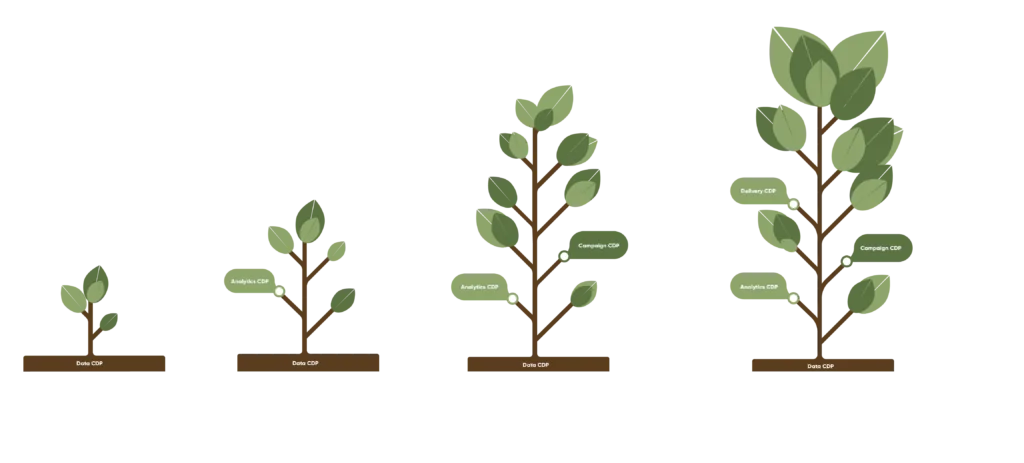Highlight

Successful together – our valantic Team.
Meet the people who bring passion and accountability to driving success at valantic.
Get to know usAugust 8, 2022

Do you have access to customer data but don’t quite know how to transition from having them to actually using them? Then a Customer Data Platform (CDP) could be the right solution for you. Find out what customer data platforms do, why they play a key role on the journey to digital success, and how they differ in their focus depending on the provider.
We are in the midst of a digital transformation that means one thing above all for businesses: It’s time to rethink the world and reinvent yourself as an organization – with all the new tools at your disposal. This multitude of new technologies presents managers with a considerable challenge.
Where do I start? What tools do I need? How do I manage ever-increasing amounts of data? This is where we’d like to start today. Data is the oxygen of digital transformation, as it – digitalization approached from a holistic perspective – creates and evolves its very own ecosystems. A viable strategy for the use of data is the prerequisite for companies to meet the challenges of our time. The solution to bring order to your data jungle: customer data platforms (CDPs).
The underlying problem are so-called data silos. These data pools are created as a side effect of a decentralized organization and separate data storage within individual departments. It is the task of CDPs to consolidate these heterogeneous data from different sources and to make them usable for their respective applications.
The overarching goal is to create a holistic customer experience and achieve successful data-driven marketing. After all, the correct handling of data promotes an understanding of customer behavior. And sustainable customer retention is one of the keys to long-term business growth.
A customer data platform is used to collect, consolidate and segment customer data from different sources. This creates a solid database from which short- to medium-term use cases (action scenarios) can be derived for marketing and other purposes. The advantage is that the CDP is accessible to other systems. This means that the data can be used to distribute personalized, user-relevant content on all digital channels.
The prerequisite for this: The stored data has been obtained in compliance with data protection regulations and with the consent of the user, for example, via a cookie bar – the magic word, in this case, is consent management.
Customer Data Platforms can have different focuses:
Important: A CDP should always be looked at in the context of the overall stack of marketing technologies used at your company.

The customer data platform cleans up, consolidates and segments customer data and thus forms the basis for the tasks of a customer experience platform (also called digital experience platform or DXP). The CXP is responsible for utilizing the processed data to deliver relevant, personalized content to users at the right time and via the right channel. All in the spirit of and for the purpose of an optimal (digital) customer experience!
Customer experience platforms can also be connected to analytics, e-commerce and marketing automation tools. This offers exponential benefits for companies.
Note: The clear demarcation between CDP and CXP is still a subject of debate in the software market. We at valantic believe that these are two disciplines that should be distinguished from each other, whereas another common usage of the terms sees CXP as part of the CDP genre.
The introduction of a CDP makes sense if …
… your company works with a tangled mess of data, and you want to finally put things in order.
… you would like to provide your contacts with relevant marketing content in a more targeted manner.
… you want to get more out of existing data in the areas of marketing, sales and customer service.
… you lack the data foundation for meaningful, personalized marketing campaigns.
… you would like to have all customer data collected on a central platform that is accessible to all key stakeholders.
The number of CDP vendors keeps growing. Big players have entered the business alongside start-ups. A selection of the most important platforms can be found below.
When selecting marketing technologies, valantic offers a best-of-breed approach. That means: We prefer creating a flexible and customized selection of platforms instead of offering a one-size-fits-all solution. Why? Because this allows us to provide our clients with a mix of technologies and tools tailored to their company. We are convinced that going this extra mile for our clients is well worth it.
Before deciding on the right MarTech package including CDP, the following steps should be taken:
Take a transparent and solution-oriented approach and consider all technology providers on the market! Which vendor meets your company’s functional, technological and organizational needs? Who strikes the perfect balance between meeting today’s requirements and mastering tomorrow’s challenges?
Tip: Try different customer data platforms, and get all stakeholders involved in the decision-making process!
We familiarized ourselves with a few providers and have assigned the individual providers’ strengths to the above-mentioned CDP genres with their respective focuses. Since CDPs – as a young but nevertheless powerful software category – are increasingly becoming the focus of smaller and larger providers, this selection can, however, only be a snapshot (as of March 2022). Considering the high development dynamics, it only serves as a rough guide.
Bloomreach Engagement is a fully integrated customer data and experience platform (CDXP) with a focus on events. Every interaction can be registered; segmentation of customers and definition of appropriate communication actions is possible in seconds.
Learn more about Bloomreach & CX …
This customer engagement platform from Berlin is an ideal campaign tool thanks to strong segmentation filters.
Salesforce CDP has only been on the market for a relatively short period of time and is therefore not 100 percent “mature” yet. We recommend it if other Salesforce products are already in use.
SAP’s customer data platform is still relatively young, still in the development stage, and thus new features are constantly being launched. In addition to the CDP, SAP Solutions also offers a Marketing Cloud with the core function of a campaign CDP and SAP Emarsys, a CEP as a complement to the CDP.
More SAP services to optimize your business processes …
Once you have found the right customer data platform, the next step is its agile implementation. At valantic, we are convinced of the agile approach because it offers the following advantages as an undogmatic and reliable project methodology:
The final stage in the implementation process: adoption and engagement. Organizational development based on the predefined target processes can be carried out, for example, by means of training and newly created positions (e.g., CDP experts).
The marked growth of the market for customer data platforms is the best indicator of the current relevance of CDPs. This makes the deliberate and careful choice of a platform that meets your company’s individual requirements all the more important. One thing must be clear: Implementing a suitable CDP is one of the most crucial steps on the path to a holistic customer experience and sustained business success.
Do you want to know more?
You can find the latest news on this topic on the valantic blog.
Got any questions? You’re welcome to contact the IT experts at valantic!
Don't miss a thing.
Subscribe to our latest blog articles.